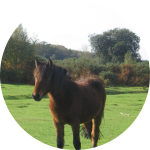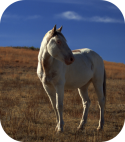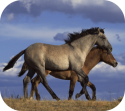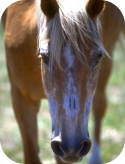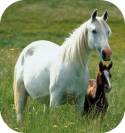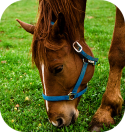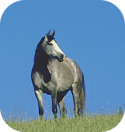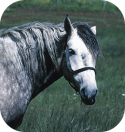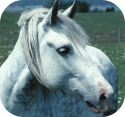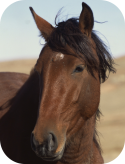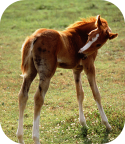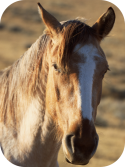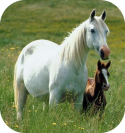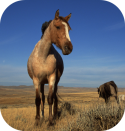|
Horses are large solid hoofed mammals.
There are approximately 400 different breeds of horse.
|
Horse Classification:
Kingdom: Animalia
Phylum: Chordata
Class: Mammalia
Order: Perissodactyla
Family: Equidae
Genus: Equus
Species: Ferus
|
Horse History: Asian nomads probably domesticated
the first horses some 4,000 years ago. Horses have remained
essential to the development and protection of many
human societies.
Other Names for Horses: Bronco, Colt, Filly,
Foal, Gelding, Mare, Mustang, Nag, Pony, Stallion, Steed,
Brumby, Cimarron,
|
Horse in Foreign Languages
Afrikaans: Perd
Albanian: Kale
Anglo-Norman: Cheval
Arabic: Faras
Chiricahua: Chelee
Jicarilla: Chelee
Lipan: Chelee
Plains Apache: Chelee
Western Apache: Chelee
Bavarian: Pferdl
Bulgarian: Kon
Chamicuro: Kawali
Chinese: Ma
Choctaw: Sobah
Cornish: Marght
Czech: Kun
Dalmatian: Cavul
Danish: Hest
Dutch: Paard / Arch
Estonian: Hobune / Hobu
Fijian: Ose
Finnish: Hevonen
French: Cheval
Gaelic: Each
Galician: Cabalo
German: Pferd / Ross / Pferdehengst / Pferdestute
Greek: Alogo
Greenlandic: Hiisti
Haitian Creole: Chwal
Hawaiian: Lio
Hebrew: Soos
Hopi: Kawayo
Hungarian: Lo
Icelandic: Hestur/ Hross
Indonesian: kuda
Irish: Capall / Each / Capaill
Italian: Cavallo
Japanese: Uma
Lakota: Tashunke
Latin: Equus / Caballus
Latvian: Zirgs
Limburgish: Peerd
Lithuanian: Arklys/ Zirgas
Low Saxon: Peerd
Luxembourgish: Paerd
Malay: Kuda
Manchu: Morin
Maori: Hoiho
Maricopa: Qwayu
Nahuatl: Cahuayoh
Navajo: Li'i''
Norman: j'va
Norwegian: Hest
Old English: Hors / Eoh / Hengest / Mearh
/ Wicg
Old French: Cheval
Old Irish: Capall
Pennsylvania German: Gaul
Polish: Kon / Klacz
Portuguese: Cavalo / egua
Romanian: Cal
Russian: Kon
Scottish: Cuddie
Roman: Konj
Sicilian: Cavaddu
Slovakian: Kon / Kone
Slovenian: Konj
Spanish: Caballo / Yegua
Sundanese: Kuda
Swahili: Farasi
Swedish: Hast / Russ / Fale
Tagalog: Kabayo
Taos: Kowena
Turkish: At / Beygir
Turkmen: At
Vietnamese: Ma
Welsh: Ceffyl
West Frisian: Hynder / Hoppe
Zulu: Ihhashi
|
Horse Size: The height of a horse is measured
in hands. One hand is equal to 4 inches. Horses come
in vastly different sizes, and weigh from 120 to 2,200
lbs. The smallest horse breed is the miniature horse
measuring less than 34 inches at the withers, the smallest
minature was around 19 inches. The largest horse breeds
are draft horses and include: the Belgian, Clydesdale,
Friesian, Percheron, and Shire. Draft horses are typically
16 to 19 hands high (64 - 76 inches tall) and weighs
1,400 to 2,000 lbs or more.
|
Horse Terms
Foal: A foal is a horse less than
a year old of either sex
Yearling: A yearling is a horse of either
sex that is between one and two years old
Colt: A colt is a male horse under the
age of four.
Filly: A filly is a female horse under
the age of four.
Mare: A mare is a female horse four years
old and older
Stallion: A stallion is a non-castrated
male horse four years old and older.
Gelding: A gelding is a castrated male
horse of any age.
|
Diet: Horses are herbivores and mainly feed
on hays and grasses.
| Horse
Habitat: Horses have adapted to a variety of
climates, they most frequently thrive in places
abundant in grass and water like grassy plains and
lower altitude mountains. |
Did You Know?
The skeletal system
of the horse develops until the age of
6.
|
|
Senses: A horse's senses are generally superior
to those of a human. Horses have excellent day and night
vision, and have the largest eye of any mammal. Horses
also have good hearing. There sense alert them to danger.
Description: Horses have a short-haired coat,
a long mane, and a long tail.
| Communication:
Horses communicate with sounds as well as body language.
Horses will move their ears to indicate pleasure,
displeasure or anger, watching a horses ears can
be very telling about their mood. They also use
tail movement to communicate. |
Did You Know?
The general rule for
distinguishing between a horse and a pony
is at maturity the height of a pony does
not exceed 14.2 hands (58 inches). An
animal 14.2 hands or more is a horse,
under is a pony. However there are many
exceptions, in Australia ponies are determined
at 14 hands.
|
|
Horse Gestation: Horses carry their young for
335-340 days.
Birth: Horses give birth to a single foal at
a time, giving birth to twins is rare.
Sexual Maturity: Horses are sexually mature
around the age of 18 months, however rarely are domesticated
horses allowed to breed before the age of 3.
Life Span: The modern domestic horse has a life
span 25 to 30 years.
Social Structure: Horses are highly social herd
animals that prefer to live in a group, typically referred
to as a herd. There is a "pecking order" within
the herd.
Athleticism: Horses have been domesticated since
ancient times and they are used for riding, for drawing
or carrying loads. A horses gallop allows them to travel
25 to 30 mph.
|
|

